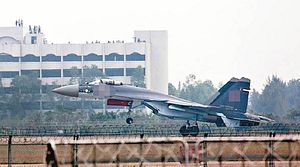The People’s Liberation Army Air Force (PLAAF) took delivery of a second batch of ten Sukhoi Su-35 multirole fighter jets, a source within the Russian government’s Federal Service for Military-Technical Cooperation revealed on December 22.
“Another batch of 10 aircraft has been sent to the customer. China will receive the remaining 10 aircraft in 2018,” the source told TASS news agency. “The first four aircraft were supplied late last year and the second batch of 10 jets will be delivered to the customer this year,” another source had told TASS in February 2017.
Neither China nor Russia have publicly confirmed that the delivery took place.
China signed a $2 billion contract for 24 Su-35 fighter aircraft in November 2015. As I reported in December 2016 (See: “Christmas Day Gift: China Received 4 Su-35 Fighter Jets From Russia”), the first four Su-35 fighters arrived on December 25 at a flight training center of the PLAAF in Cangzhou City in Hebei province in northern China.
The per-unit cost of the Su-35 is estimated at $83 to $85 million. The contract includes training, ground, and logistical support. China first expressed interest in the Su-35 in 2008; official negotiations began in 2011. A preliminary agreement was reached in 2012.
The Su-35S (NATO reporting name: Flanker-E) is an improved fourth generation, twin-engine, multirole fighter aircraft powered by two AL-117S turbofan engines. The Su-35S is the latest variant of Russia’s Flanker-series.
The aircraft features an export-standard radar system — the Irbis-E passive-electronically scanned-array radar, capable of tracking up to 30 targets simultaneously and purportedly able to engage up to eight — an electronic warfare and communications suite, as well as a newly integrated receiver for the domestically-built BeiDou satellite navigation system.
As I explained previously, China is especially interested in the Su-35’s jet engine (See: “China to Receive 4 Su-35 Fighter Jets From Russia in 2016”):
One of the reasons for China’s interest in the Su-35 is its AL-117S turbofan engine. Russia has repeatedly refused to sell the engine as a stand-alone product, which left the PLAAF with little choice but to acquire the entire aircraft. The Chinese military aviation industry is still struggling with designing and building an engine for its new fifth-generation stealth fighter prototype, the Chengdu J-20.
China will likely try to reverse engineer parts of the AL117S turbofan engine. Chinese-made fighter jets continue to rely on Russian-made jet engines, as I explained elsewhere:
The J-20 reportedly is fitted with the Saturn AL-31, an older Russian-made jet engine. Another fifth generation fighter jet, the Shenyang J-31, is equipped with the Klimov RD-93. China is currently working on its own jet engine, the WS-13 Taishan turbofan, a derivative of the Russian Klimov RD-33 turbofan. Both the J-31 and J-20 are purportedly incapable of super cruising — sustained supersonic flight.
In August 2016, China announced that it set up a new state-owned aircraft engine maker to accelerate the development of new high-performance turbofan engines for the PLAAF. The remaining ten Su-35S aircraft are expected to be delivered by the end of 2018.
































